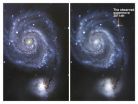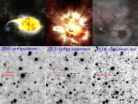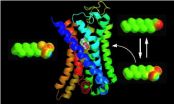(Press-News.org) This release is available in Japanese.
A team led by Gastón Folatelli at the Kavli IPMU, the University of Tokyo, has found evidence of a hot binary companion star to a yellow supergiant star, which had become a bright supernova. The existence of the companion star had been predicted by the same team on the basis of numerical calculations. This finding provides the last link in a chain of observations that have so far supported the team's theoretical picture for this supernova. The results are published in the Astrophysical Journal Letters and have wide implications for our knowledge of binary systems and supernova mechanisms.
"One of the most exciting moments in my career as an astronomer was when I displayed the newly arrived HST images and saw the object right there, where we had anticipated it to be all along" said Gastón Folatelli , who led the efforts to obtain the new Hubble Space Telescope (HST) observations.
The question of how massive stars spend their short lives until they become supernovae is of great interest for astrophysicists. According to the standard theory, which is only applicable to isolated stars, only cool and extended (red supergiants) or hot and blue (Wolf-Rayet stars) are able to become supernovae. However, growing evidence suggests that most massive stars are not lonely singles but they belong to close binary systems with profuse interactions. Episodes of mass transfer between the members of binary star systems affect the way the stars evolve, meaning that there are a great many more potential scenarios for the final stages of supernova progenitors.
The nearby supernova SN 2011dh, which occurred in 2011 in the well-known whirlpool galaxy M51, which is about 24 million light-years away from the earth, presented an excellent example that could not be explained by the standard theory. What appeared to be a yellow supergiant star was detected at the location of the supernova in images obtained before the explosion, but yellow supergiant stars in isolation were not thought capable of becoming supernovae. Controversy arose in the astronomy community with several experts proposing that the actual progenitor must have been an unseen bright blue object, such as a Wolf Rayet star. However, the team led by Melina C. Bersten at Kavli IPMU and Omar Benvenuto at the University of La Plata, Argentina, showed that the exploding star must have been extended, like a yellow supergiant, and that it must have belonged to a binary system (see web release on September 28 2012: http://www.ipmu.jp/node/1404). "We produced detailed models that self-consistently explained every property of SN 2011dh through the explosion of a yellow supergiant star in a binary system," remarked Melina C. Bersten.
In March 2013, the proposal of Benvenuto, Bersten and collaborators was given substantial support when the disappearance of the yellow supergiant was observed, indicating that it and not a bright blue star was the exploding object (see web release on Apr. 5 2013: http://www.ipmu.jp/node/1537). "At that time there was just one piece of the puzzle missing to confirm our model: we had to find the companion star that, according to our calculations, was a hot, compact object," said Omar Benvenuto.
With that goal, the group set out to obtain HST observing time, which was granted in 2013 and recently executed on August 7, 2014. Images were obtained in the ultraviolet regime, where the companion star was expected to be most clearly visible. A point source was clearly detected in the new images at the exact location of the supernova (see announcement in http://www.astronomerstelegram.org/?read=6375). "To our excitement, the object had the properties predicted by the models," explained Schuyler Van Dyk, of Caltech, who was in charge of the image analysis. Folatelli and collaborators judged it unlikely that the detection was due to some other contaminating source.
Further HST observations were recently obtained in the optical range by another European team. "When available, such data will not only serve to definitely validate the existence of the companion star, but also they will provide critical information to refine the binary model originally proposed by our team", said Ken'ichi Nomoto from Kavli IPMU. This is a unique opportunity to make such a detailed study of the progenitor of a supernova. The results will have important implications for our knowledge of stellar evolution and its connection with supernova properties.
The case of SN 2011dh beautifully illustrates the advantages of an active feedback between theory and observation. "As a scientist, for me it is like a dream come true to make a prediction and have it confirmed step by step as the supernova evolves and facts are revealed. It is a rare case for astronomy, where events usually take much longer to develop. We are very happy with how the story of SN 2011dh proceeded," concluded Melina C. Bersten.
INFORMATION:
Publication:
Gastón Folatelli, Melina C. Bersten, Omar G. Benvenuto, Schuyler D. Van Dyk, Hanindyo Kuncarayakti, Keiichi Maeda, Takaya Nozawa, Ken'ichi Nomoto, Mario Hamuy, and Robert M. Quimby, "A Blue Point Source at the Location of Supernova 2011dh," Astrophysical Journal Letters.
Contacts:
Gastón Folatelli, Kavli Institute for the Physics and Mathematics of the Universe, The University of Tokyo
+81-4-7136-6565, gaston.folatelli@ipmu.jp
Melina C. Bersten, Kavli Institute for the Physics and Mathematics of the Universe, The University of Tokyo
+81-4-7136-6562, melina.bersten@ipmu.jp
Ken'ichi Nomoto, Kavli Institute for the Physics and Mathematics of the Universe, The University of Tokyo
+81-4-7136-6567, nomoto@astron.s.u-tokyo.ac.jp
PIO Contact:
Marina Komori, Kavli Institute for the Physics and Mathematics of the Universe, The University of Tokyo
+81-4-7136-5977 (office), +81-80-9343-3171 (mobile), press@ipmu.jp
Aya Tsuboi, Kavli Institute for the Physics and Mathematics of the Universe, The University of Tokyo
+81-4-7136-5981 (office)
ABOUT KAVLI IPMU
Kavli IPMU (Kavli Institute for the Physics and Mathematics of the Universe) is an international research institute with English as its official language. The goal of the institute is to discover the fundamental laws of nature and to understand the Universe from the synergistic perspectives of mathematics, astronomy, and theoretical and experimental physics. The Institute for the Physics and Mathematics of the Universe (IPMU) was established in October 2007 under the World Premier International Research Center Initiative (WPI) of the Ministry of Education, Sports, Science and Technology in Japan with the University of Tokyo as the host institution. IPMU was designated as the first research institute within Todai Institutes for Advanced Study (TODIAS) in January 2011. It received an endowment from The Kavli Foundation and was renamed the "Kavli Institute for the Physics and Mathematics of the Universe" in April 2012. Kavli IPMU is located on the Kashiwa campus of the University of Tokyo, and more than half of its full-time scientific members come from outside Japan.
Kavli IPMU Website - http://www.ipmu.jp/
Lurking bright blue star caught!
The last piece of a supernova puzzle
2014-09-11
ELSE PRESS RELEASES FROM THIS DATE:
High levels of physical activity linked to better academic performance in boys
2014-09-11
A recent Finnish study shows that higher levels of physical activity are related to better academic achievement during the first three school years particularly in boys. The study published in PLOS ONE was conducted in collaboration with the Physical Activity and Nutrition in Children (PANIC) Study conducted at the University of Eastern Finland and the First Steps Study at the University of Jyväskylä.
The study investigated the relationships of different types of physical activity and sedentary behavior assessed in the first grade to reading and arithmetic skills in grades ...
Smokers who consume too much sodium at greater risk of developing rheumatoid arthritis
2014-09-11
A new study published online in the journal Rheumatology today indicates that the interaction between high sodium intake and smoking is associated with a more than doubled risk of developing rheumatoid arthritis (RA).
The study, carried out by Björn Sundström and colleagues from the Department of Public Health and Clinical Medicine, Rheumatology at Umeå University, Sweden, was carried out to see whether recent animal and human cell study results that showed a link between a high sodium intake and RA would yield similar results in a nested case-control study of data from ...
'Fat shaming' doesn't encourage weight loss
2014-09-11
Discrimination against overweight and obese people does not help them to lose weight, finds new UCL research funded by Cancer Research UK.
In a study of 2,944 UK adults over four years, those who reported experiencing weight discrimination gained more weight than those who did not. On average, after accounting for baseline differences, people who reported weight discrimination gained 0.95kg whereas those who did not lost 0.71kg, a difference of 1.66kg.
The research, published in the journal Obesity, contradicts the common perception that discrimination or 'fat shaming' ...
More needed to protect our sportspeople from brain injury, say Birmingham experts
2014-09-11
Two University of Birmingham academics are calling for more research to be carried out looking at how the brains of sportspeople – including children – react when they receive a blow to the head.
Their call is echoed by Dawn Astle and Peter Robinson. Dawn Astle, is the daughter of former West Bromwich Albion player Jeff Astle who, an inquest found, died from brain trauma caused by heading heavy footballs - a condition known as Chronic Traumatic Encephalopathy (CTE). Peter Robinson is the father of Ben Robinson, whose son died as a result of repeated concussions during ...
The Lancet Diabetes & Endocrinology: 1 in 4 people with diabetes worldwide live in China, but a new approach could help transform their care
2014-09-11
Diabetes has become a major public health crisis in China, with an annual projected cost of 360 billion RMB (nearly 35 billion British pounds) by 2030, but a new collaborative approach to care that uses registries and community support could help improve diabetes care, according to a new three-part Series about diabetes in China published in The Lancet Diabetes & Endocrinology.
China has the largest number of people with diabetes of any country in the world, and the disease has reached epidemic proportions in the adult population [Paper 1]. In 1980, less than 1% of Chinese ...
Study: Role of emergency contact is mistaken for advance directive
2014-09-11
DETROIT – More than 95 percent of patients treated in an Emergency Department mistake their emergency contact as the designated medical decision maker for end-of-life care, according to a new study by Henry Ford Hospital in Detroit.
The study is being presented Wednesday at the 20th International Congress on Palliative Care in Montreal.
Erin Zimny, M.D., a Henry Ford Emergency Medicine and Palliative Care physician and a study co-author, attributes the misunderstanding to health care practitioners routinely asking patients for their emergency contact information without ...
Genomic analysis reveals that a high-risk leukemia subtype becomes more common with age
2014-09-11
More than one-quarter of young adults with the most common form of acute lymphoblastic leukemia (ALL) have a high-risk subtype with a poor prognosis and may benefit from drugs widely used to treat other types of leukemia that are more common in adults, according to multi-institutional research led by St. Jude Children's Research Hospital investigators. The study appears in the current issue of The New England Journal of Medicine.
ALL is the most common childhood cancer. The research focused on a subtype of ALL known as Philadelphia chromosome-like ALL (Ph-like ALL). In ...
Chemists discover way nose perceives common class of odors
2014-09-11
Biologists claim that humans can perceive and distinguish a trillion different odors, but little is known about the underlying chemical processes involved. Biochemists at The City College of New York have found an unexpected chemical strategy employed by the mammalian nose to detect chemicals known as aldehydes.
According to a team led by CCNY Associate Professor of Chemistry Kevin Ryan and Columbia biologist Stuart Firestein, some of the nose's many aldehyde receptors don't detect the aldehyde by its structure and shape directly. Rather, the aldehyde is recognized by ...
Small weight gain can raise blood pressure in healthy adults
2014-09-10
Gaining just five pounds can increase your blood pressure, according to a study presented at the American Heart Association's High Blood Pressure Research Scientific Sessions 2014.
Many people understand the health dangers of large amounts of extra body weight, but reasearchers in this study wanted to see the impact of a small weight gain of about five to 11 pounds.
"To our knowledge, for the first time, we showed that the blood pressure increase was specifically related to increases in abdominal visceral fat, which is the fat inside the abdomen," said Naima ...
Using plants to produce enzyme may provide treatment for high blood pressure in lungs
2014-09-10
Using plant leaves to produce and deliver a key enzyme may improve treatment for life-threatening high blood pressure in the lungs, according to a study presented at the American Heart Association's High Blood Pressure Research Scientific Sessions 2014.
"Current therapies for pulmonary hypertension don't cure the underlying disorder and the long-term prognosis is poor, even with treatment," said Vinayak Shenoy, Ph.D., the study's lead author and an assistant research scientist at the University of Florida in Gainesville. "There is an urgent need to discover potential ...
LAST 30 PRESS RELEASES:
Numbers in our sights affect how we perceive space
SIMJ announces global collaborative book project in commemoration of its 75th anniversary
Air pollution exposure and birth weight
Obstructive sleep apnea risk and mental health conditions among older adults
How talking slows eye movements behind the wheel
The Ceramic Society of Japan’s Oxoate Ceramics Research Association launches new international book project
Heart-brain connection: international study reveals the role of the vagus nerve in keeping the heart young
Researchers identify Rb1 as a predictive biomarker for a new therapeutic strategy in some breast cancers
Survey reveals ethical gaps slowing AI adoption in pediatric surgery
Stimulant ADHD medications work differently than thought
AI overestimates how smart people are, according to HSE economists
HSE researchers create genome-wide map of quadruplexes
Scientists boost cell "powerhouses" to burn more calories
Automatic label checking: The missing step in making reliable medical AI
Low daily alcohol intake linked to 50% heightened mouth cancer risk in India
American Meteorological Society announces Rick Spinrad as 2026 President-Elect
Biomass-based carbon capture spotlighted in newly released global climate webinar recording
Illuminating invisible nano pollutants: advanced bioimaging tracks the full journey of emerging nanoscale contaminants in living systems
How does age affect recovery from spinal cord injury?
Novel AI tool offers prognosis for patients with head and neck cancer
Fathers’ microplastic exposure tied to their children’s metabolic problems
Research validates laboratory model for studying high-grade serous ovarian cancer
SIR 2026 delivers transformative breakthroughs in minimally invasive medicine to improve patient care
Stem Cell Reports most downloaded papers of 2025 highlight the breadth and impact of stem cell research
Oxford-led study estimates NHS spends around 3% of its primary and secondary care budget on the health impacts of heat and cold in England
A researcher’s long quest leads to a smart composite breakthrough
Urban wild bees act as “microbial sensors” of city health.
New study finds where you live affects recovery after a hip fracture
Forecasting the impact of fully automated vehicle adoption on US road traffic injuries
Alcohol-related hospitalizations from 2016 to 2022
[Press-News.org] Lurking bright blue star caught!The last piece of a supernova puzzle



